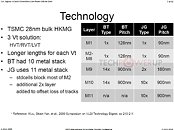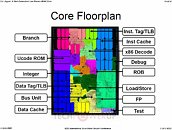Tuesday, February 19th 2013

AMD "Jaguar" Micro-architecture Takes the Fight to Atom with AVX, SSE4, Quad-Core
AMD hedged its low-power CPU bets on the "Bobcat" micro-architecture for the past two years now. Intel's Atom line of low-power chips caught up in power-efficiency, CPU performance, to an extant iGPU performance, and recent models even feature out-of-order execution. AMD unveiled its next-generation "Jaguar" low-power CPU micro-architecture for APUs in the 5W - 25W TDP range, targeting everything from tablets to entry-level notebooks, and nettops.
At its presentation at the 60th ISSC 2013 conference, AMD detailed "Jaguar," revealing a few killer features that could restore the company's competitiveness in the low-power CPU segment. To begin with, APUs with CPU cores based on this micro-architecture will be built on TSMC's 28-nanometer HKMG process. Jaguar allows for up to four x86-64 cores. The four cores, unlike Bulldozer modules, are completely independent, and only share a 2 MB L2 cache."Jaguar" x86-64 cores feature a 40-bit wide physical address (Bobcat features 36-bit), 16-byte/cycle load/store bandwidth, which is double that of Bobcat, a 128-bit wide FPU data-path, which again is double that of Bobcat, and about 50 percent bigger scheduler queues. The instruction set is where AMD is looking to rattle Atom. Not only does Jaguar feature out-of-order execution, but also ISA instruction sets found on mainstream CPUs, such as AVX (advanced vector extensions), SIMD instruction sets such as SSSE3, SSE4.1, SSE4.2, and SSE4A, all of which are quite widely adopted by modern media applications. Also added is AES-NI, which accelerates AES data encryption. In the efficiency department, AMD claims to have improved its power-gating technology that completely cuts power to inactive cores, to conserve battery life.
At its presentation at the 60th ISSC 2013 conference, AMD detailed "Jaguar," revealing a few killer features that could restore the company's competitiveness in the low-power CPU segment. To begin with, APUs with CPU cores based on this micro-architecture will be built on TSMC's 28-nanometer HKMG process. Jaguar allows for up to four x86-64 cores. The four cores, unlike Bulldozer modules, are completely independent, and only share a 2 MB L2 cache."Jaguar" x86-64 cores feature a 40-bit wide physical address (Bobcat features 36-bit), 16-byte/cycle load/store bandwidth, which is double that of Bobcat, a 128-bit wide FPU data-path, which again is double that of Bobcat, and about 50 percent bigger scheduler queues. The instruction set is where AMD is looking to rattle Atom. Not only does Jaguar feature out-of-order execution, but also ISA instruction sets found on mainstream CPUs, such as AVX (advanced vector extensions), SIMD instruction sets such as SSSE3, SSE4.1, SSE4.2, and SSE4A, all of which are quite widely adopted by modern media applications. Also added is AES-NI, which accelerates AES data encryption. In the efficiency department, AMD claims to have improved its power-gating technology that completely cuts power to inactive cores, to conserve battery life.








71 Comments on AMD "Jaguar" Micro-architecture Takes the Fight to Atom with AVX, SSE4, Quad-Core
Sony and Microsoft made a good choice for their consoles (going with an octacore instead of a quadcore), and AMD made a good move.Sweet.
CPUsAPUs. :rockout:Notice the "GCN" bit... obviously gonna end up named up as HD 8000 something... even tho it isn't known yet if it's GCN 1 or 2.
Also, you might be interested in this:
AMD Temash Prototype plays DiRT Showdown at 1080p ...
To be honest, I'm surprised these slides/videos aren't more known of...
Jaguar: Real quad-core with real cores.
We're not even talking modules. This is the real deal. So real they decided to keep using it. :pI dig that displayport hub at the end of that video. :rockout:
Nice to see AMD moving forward with another excellent product that should sell well. This is definitely a win for consumers as Jaguar has a lot of potential and widespread application. You can bet that the next round of desktop CPUs and APUs will have similar but imrpoved features.
this should shake up the low end market a decent amount. intel atom is just too damn slow. aint nobody got time for it.